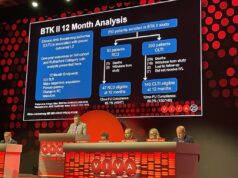
The final 1,373-patient cohort analysis from the Disrupt PAD III observational study (OS) demonstrates consistent intravascular lithotripsy (IVL; Shockwave Medical) outcomes in complex and challenging lesions across multiple peripheral vessel beds.
Ehrin Armstrong (Adventist Heart and Vascular Institute, St Helena, USA), presented this conclusion during a late-breaking clinical trials session at Vascular Interventional Advances (VIVA) 2022 (31 October–3 November), noting that the study represents the largest prospective “real-world” evidence supporting the treatment of complex, heavily calcified peripheral arterial disease (PAD) with IVL.
The key findings from Disrupt PAD III OS include:
- IVL resulted in consistent reduction in the diameter of stenosis with no associated distal embolisation, abrupt closure or thrombotic events at any time
- IVL was the only calcium-modifying therapy used in most cases, required a limited need for adjunctive therapy tools (i.e. embolic protection), and had better results with appropriate IVL sizing
- IVL results were comparable to the previously reported outcomes from the Disrupt PAD III randomised clinical trial (RCT) showing that IVL safely and effectively modifies calcium across multiple peripheral vessel beds
“These consistent results in a ‘real-world’ population, combined with the recent long-term outcomes from the Disrupt PAD III RCT, reinforce the positioning of IVL as a reliable, potential first-line therapy for the treatment of large and diverse patient populations with calcified PAD,” said Armstrong. “The significant amount of data on IVL continue to show both consistent efficacy and safety across the most challenging lesions, various peripheral vessel beds, and even in the most complex, high-risk patients.”
Disrupt PAD III OS is a prospective, multicentre, single-blind study of “real-world” patients. The analysis looked at the total 1,373-patient cohort enrolled in the study from November 2017 to June 2021 at 30 global sites.
Of the 1,531 lesions treated in the iliac, common femoral, superficial femoral, popliteal and infrapopliteal arteries, 90% presented with moderate/severe calcification, with an average calcified length of 115mm. At VIVA 2022, Armstrong reported that the use of IVL in these lesions resulted in a final residual diameter stenosis of 24%, similar to Disrupt PAD III RCT (22%).
The presenter also revealed that patients experienced minimal procedural complications, with only 0.7% and 0.2% experiencing final dissections (Type D–F) and perforations, respectively. Notably, there were no instances of embolisation, thrombus formation, no reflow or abrupt closure.













